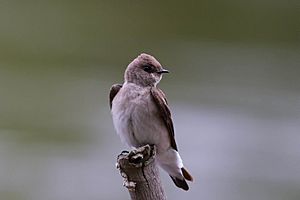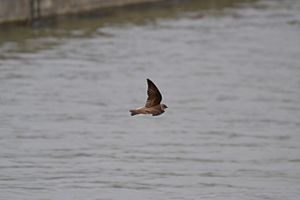Northern rough-winged swallow facts for kids
The northern rough-winged swallow (Stelgidopteryx serripennis) is a small bird that travels long distances. It is a type of swallow and looks very similar to the southern rough-winged swallow.
Quick facts for kids Northern rough-winged swallow |
|
|---|---|
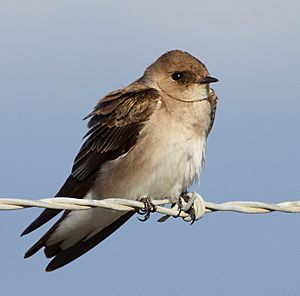 |
|
| Adult | |
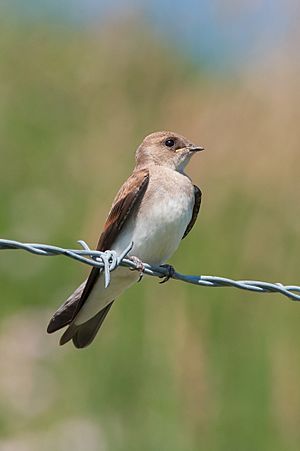 |
|
| Juvenile | |
| Conservation status | |
| Scientific classification | |
| Genus: |
Stelgidopteryx
|
| Species: |
serripennis
|
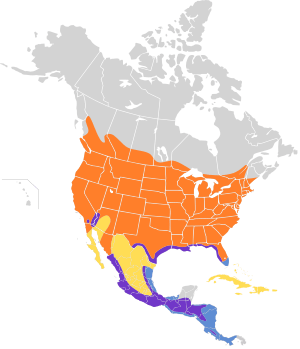 |
|
Contents
About the Name
The scientific name for this swallow, Stelgidopteryx, comes from Ancient Greece. It means "scraper wing." The second part of its name, serripennis, comes from Latin and means "saw feather."
The common name "rough-winged" comes from the special feathers on the edge of its wing. These feathers have a serrated or saw-like edge. You would only notice this if you held the bird.
Different Types of Northern Rough-winged Swallows
Scientists currently recognize six different types, or subspecies, of the northern rough-winged swallow. These different types live in various parts of North and Central America.
For example, one type, S. s. serripennis, lives in southern Alaska and Canada down to the southern United States. Another type, S. s. fulvipennis, lives in central Mexico to Costa Rica. These different types can have slight differences in their color or size.
What They Look Like
Adult northern rough-winged swallows are about 13 to 15 centimeters (5 to 6 inches) long. They are brown on top and have white underparts. They have a small bill and a tail that looks forked. Their throat is white with a brownish-grey color, and their belly is white.
These birds have a wingspan of about 27 to 30 cm (11 to 12 in) and weigh between 10 to 18 grams (0.35 to 0.63 oz). Male swallows have slightly different feathers under their tail and on their wings compared to females. Young swallows can be identified by reddish-brown bars on their wings.
They look a lot like the bank swallow, but the northern rough-winged swallow has a darker throat and chest.
Their Call
The sound this swallow makes is a short, harsh "zeep." It can also sound like a rough, low "bzzt." They often make this sound twice. It is similar to the call of the bank swallow.
Where They Live
The northern rough-winged swallow is found in many countries. These include Canada, the United States, Mexico, and many countries in Central America like Costa Rica and Panama. They also live in some Caribbean islands like The Bahamas and Cuba.
Birds from the US and Canada usually fly south for winter. They spend the colder months in the southernmost US and further south. However, swallows living in Mexico and further south usually do not migrate. They stay in their home areas all year. These swallows can be found in high places, sometimes as high as 2,500 meters (8,200 feet) in Costa Rica.
Life and Habits
Nesting and Reproduction
Northern rough-winged swallows usually build their nests alone. Sometimes, they might nest in small groups of up to 25 pairs. They often choose burrows in soil banks, but sometimes they use caves, trees, or even human-made spots like gutters.
These burrows are usually dug by other animals. They can be anywhere from 20 to 200 cm (8 to 79 in) long, but most are between 30 and 100 cm (12 and 39 in). The nests are usually found about 0.2 to 30 meters (0.7 to 98 ft) above the ground.
The female swallow builds the nest using different plant materials. These include grasses, leaves, roots, twigs, bark, and pine needles. They also use moss and animal dung. The inside of the nest is then lined with soft grass.
The breeding season usually runs from May to mid-July. However, this can change depending on the region. In warmer areas, they lay their eggs earlier, sometimes from mid-April to mid-May.
A female swallow lays one clutch of four to eight glossy white eggs. Each egg is about 20 by 14 millimeters (0.79 by 0.55 in). The female sits on the eggs to keep them warm, a process called incubation. This takes about 16 to 18 days. Since she starts incubating as soon as the first egg is laid, the eggs hatch at slightly different times.
Migration Habits
After the breeding season, northern rough-winged swallows often gather in large groups. They rest together in marshy areas. When the weather is bad, several swallows might even share a burrow to stay safe. They fly to the Gulf Coast of the United States and further south to Central America for winter. Some also spend winter in the Caribbean.
What They Eat
When looking for food, these swallows fly low and straight. Their flight has slow, deep wingbeats, with periods of gliding. They usually hunt for food over water, but sometimes over land. They are insectivores, meaning they eat almost only flying insects. To drink, they skim the surface of the water with their wings and then drink while still flying.
Conservation Status
The IUCN says the northern rough-winged swallow is a least concern species. This means it is not currently in danger of disappearing. Even though its population is slowly decreasing, it is not happening fast enough to be a big worry. Also, there are about 15 million of these birds, which is a large number. This swallow has learned to live well near humans and sometimes nests in places people have built.
See also
 In Spanish: Golondrina aserrada para niños
In Spanish: Golondrina aserrada para niños



